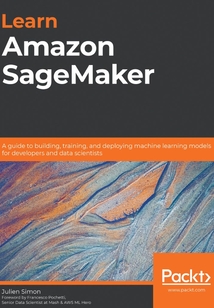舉報 

會員
Learn Amazon SageMaker
Quicklybuildanddeploymachinelearningmodelswithoutmanaginginfrastructure,andimproveproductivityusingAmazonSageMaker’scapabilitiessuchasAmazonSageMakerStudio,Autopilot,Experiments,Debugger,andModelMonitorKeyFeatures*Build,train,anddeploymachinelearningmodelsquicklyusingAmazonSageMaker*Analyze,detect,andreceivealertsrelatingtovariousbusinessproblemsusingmachinelearningalgorithmsandtechniques*Improveproductivitybytrainingandfine-tuningmachinelearningmodelsinproductionBookDescriptionAmazonSageMakerenablesyoutoquicklybuild,train,anddeploymachinelearning(ML)modelsatscale,withoutmanaginganyinfrastructure.IthelpsyoufocusontheMLproblemathandanddeployhigh-qualitymodelsbyremovingtheheavyliftingtypicallyinvolvedineachstepoftheMLprocess.ThisbookisacomprehensiveguidefordatascientistsandMLdeveloperswhowanttolearntheinsandoutsofAmazonSageMaker.You’llunderstandhowtousevariousmodulesofSageMakerasasingletoolsettosolvethechallengesfacedinML.Asyouprogress,you’llcoverfeaturessuchasAutoML,built-inalgorithmsandframeworks,andtheoptionforwritingyourowncodeandalgorithmstobuildMLmodels.Later,thebookwillshowyouhowtointegrateAmazonSageMakerwithpopulardeeplearninglibrariessuchasTensorFlowandPyTorchtoincreasethecapabilitiesofexistingmodels.You’llalsolearntogetthemodelstoproductionfasterwithminimumeffortandatalowercost.Finally,you’llexplorehowtouseAmazonSageMakerDebuggertoanalyze,detect,andhighlightproblemstounderstandthecurrentmodelstateandimprovemodelaccuracy.BytheendofthisAmazonbook,you’llbeabletouseAmazonSageMakeronthefullspectrumofMLworkflows,fromexperimentation,training,andmonitoringtoscaling,deployment,andautomation.Whatyouwilllearn*Createandautomateend-to-endmachinelearningworkflowsonAmazonWebServices(AWS)*Becomewell-versedwithdataannotationandpreparationtechniques*UseAutoMLfeaturestobuildandtrainmachinelearningmodelswithAutoPilot*Createmodelsusingbuilt-inalgorithmsandframeworksandyourowncode*TraincomputervisionandNLPmodelsusingreal-worldexamples*Covertrainingtechniquesforscaling,modeloptimization,modeldebugging,andcostoptimization*AutomatedeploymenttasksinavarietyofconfigurationsusingSDKandseveralautomationtoolsWhothisbookisforThisbookisforsoftwareengineers,machinelearningdevelopers,datascientists,andAWSuserswhoarenewtousingAmazonSageMakerandwanttobuildhigh-qualitymachinelearningmodelswithoutworryingaboutinfrastructure.KnowledgeofAWSbasicsisrequiredtograsptheconceptscoveredinthisbookmoreeffectively.SomeunderstandingofmachinelearningconceptsandthePythonprogramminglanguagewillalsobebeneficial.
目錄(116章)
倒序
- coverpage
- Learn Amazon SageMaker
- Learn Amazon SageMaker
- Why subscribe?
- Contributors
- About the author
- About the reviewers
- Packt is searching for authors like you
- Foreword
- Preface
- Who this book is for
- What this book covers
- To get the most out of this book
- Download the example code files
- Download the color images
- Conventions used
- Get in touch
- Reviews
- Section 1: Introduction to Amazon SageMaker
- Chapter 1: Introduction to Amazon SageMaker
- Technical requirements
- Exploring the capabilities of Amazon SageMaker
- Demonstrating the strengths of Amazon SageMaker
- Setting up Amazon SageMaker on your local machine
- Setting up an Amazon SageMaker notebook instance
- Setting up Amazon SageMaker Studio
- Summary
- Chapter 2: Handling Data Preparation Techniques
- Technical requirements
- Discovering Amazon SageMaker Ground Truth
- Exploring Amazon SageMaker Processing
- Processing data with other AWS services
- Summary
- Section 2: Building and Training Models
- Chapter 3: AutoML with Amazon SageMaker Autopilot
- Technical requirements
- Discovering Amazon SageMaker Autopilot
- Using SageMaker Autopilot in SageMaker Studio
- Using the SageMaker Autopilot SDK
- Diving deep on SageMaker Autopilot
- Summary
- Chapter 4: Training Machine Learning Models
- Technical requirements
- Discovering the built-in algorithms in Amazon SageMaker
- Training and deploying models with built-in algorithms
- Using the SageMaker SDK with built-in algorithms
- Working with more built-in algorithms
- Summary
- Chapter 5: Training Computer Vision Models
- Technical requirements
- Discovering the CV built-in algorithms in Amazon SageMaker
- Preparing image datasets
- Using the built-in CV algorithms
- Summary
- Chapter 6: Training Natural Language Processing Models
- Technical requirements
- Discovering the NLP built-in algorithms in Amazon SageMaker
- Preparing natural language datasets
- Using the built-in algorithms for NLP
- Summary
- Chapter 7: Extending Machine Learning Services Using Built-In Frameworks
- Technical requirements
- Discovering the built-in frameworks in Amazon SageMaker
- Running your framework code on Amazon SageMaker
- Using the built-in frameworks
- Summary
- Chapter 8: Using Your Algorithms and Code
- Technical requirements
- Understanding how SageMaker invokes your code
- Using the SageMaker training toolkit with scikit-learn
- Building a fully custom container for scikit-learn
- Building a fully custom container for R
- Training and deploying with XGBoost and MLflow
- Training and deploying with XGBoost and Sagify
- Summary
- Section 3: Diving Deeper on Training
- Chapter 9: Scaling Your Training Jobs
- Technical requirements
- Understanding when and how to scale
- Streaming datasets with pipe mode
- Using other storage services
- Distributing training jobs
- Training an Image Classification model on ImageNet
- Summary
- Chapter 10: Advanced Training Techniques
- Technical requirements
- Optimizing training costs with Managed Spot Training
- Optimizing hyperparameters with Automatic Model Tuning
- Exploring models with SageMaker Debugger
- Summary
- Section 4: Managing Models in Production
- Chapter 11: Deploying Machine Learning Models
- Technical requirements
- Examining model artifacts
- Managing real-time endpoints
- Deploying batch transformers
- Deploying inference pipelines
- Monitoring predictions with Amazon SageMaker Model Monitor
- Deploying models to container services
- Summary
- Chapter 12: Automating Machine Learning Workflows
- Technical requirements
- Automating with AWS CloudFormation
- Automating with the AWS Cloud Development Kit
- Automating with AWS Step Functions
- Summary
- Chapter 13: Optimizing Prediction Cost and Performance
- Technical requirements
- Autoscaling an endpoint
- Deploying a multi-model endpoint
- Deploying a model with Amazon Elastic Inference
- Compiling models with Amazon SageMaker Neo
- Building a cost optimization checklist
- Summary
- Other Books You May Enjoy
- Leave a review - let other readers know what you think 更新時間:2021-04-09 23:11:46
推薦閱讀
- 審計全流程技術操作實務指南
- 汪博士詳解PMP?模擬題(第4版)
- Splunk:Enterprise Operational Intelligence Delivered
- Microsoft Dynamics NAV Financial Management
- Metabase Up and Running
- 企業能源審計與節能規劃
- 財務審計實務指南
- vSphere Design Best Practices
- 陜西國家統計調查市、縣優秀報告集萃(2006—2015)(上下)
- Oracle Primavera Contract Management,Business Intelligence Publisher Edition v14
- 內部審計情景案例:理解審計行為,辨析審計決策
- 2014年注冊會計師(CPA)全國統考專用輔導教材系列:審計(名師解讀版)
- 審計學理論與實務
- Oracle Enterprise Manager 12c Administration Cookbook
- 政府采購評審專家工作指南
- 審計基礎與實務(第二版)
- TIBCO Spotfire for Developers
- 審計效率手冊:用Excel高效完成審計工作
- Getting Started with BizTalk Services
- 風險導向內部審計實務指南
- Microsoft Exchange Server 2013 High Availability
- 公司內部審計(第3版)
- HP Vertica Essentials
- Learning Windows Azure Mobile Services for Windows 8 and Windows Phone 8
- 審計學
- 會計崗位實訓(第2版)
- Mastering the Microsoft Deployment Toolkit
- 趣學貝葉斯統計:橡皮鴨、樂高和星球大戰中的統計學
- 21世紀經濟學研究生規劃教材:空間計量經濟學
- 審計理論研究:基礎理論視角(國家社科基金后期資助項目)

